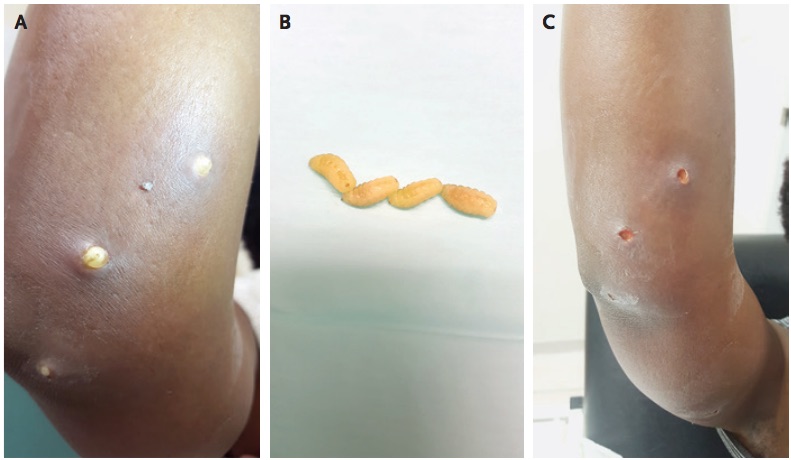Woman's Painful Sores Are Not Bug Bites, But Burrowing Bugs

Strange sores on a woman's swollen skin weren't caused by an insect bite, but by insects burrowing into her skin, according to a recent report of the woman's case.
When the 46-year-old woman went to the emergency room in the United Kingdom with painful marks on her arm, the doctors initially thought she had been bitten by an insect. She was given antibiotics and sent home.
But when the woman returned the next day because the pain in her arm was getting worse, the doctors realized they were dealing with no ordinary skin infection: In the ulcerations on her skin, something was wiggling, according to a recent report of the woman's case. [Here's a Giant List of the Strangest Medical Cases We've Covered]
The doctors found several fly larvae burrowed into her skin, according to the report, published today (March 29) in The New England Journal of Medicine.
The larvae were from the tumbu fly (Cordylobia anthropophaga), a species found in the tropics of Africa, according to the report. Indeed, the woman had recently returned from a trip to the Ivory Coast, a country in West Africa, the doctors wrote.
The tumbu fly is sometimes referred to as the putzi fly or the "skin maggot," according to the report. Other fly species are also known to burrow into people's skin, including the human bot fly (Dermatobia hominis) and the Old World screwworm (Chrysomya bezziana), according to the Centers for Disease Control and Prevention.
Female tumbu flies can lay their eggs on damp clothing or in soil, and if these eggs come into contact with a person's skin, they can burrow in, according to the report. Typically, larvae are found burrowed into the skin on a person’s back, buttocks or the back of the legs, the doctors said in the case report.
Sign up for the Live Science daily newsletter now
Get the world’s most fascinating discoveries delivered straight to your inbox.
The doctors initially tried to squeeze the larvae out of the woman's arm, but ended up having to remove them surgically, said Dr. John Park, a medical resident who treated the woman while working in England in 2016, and is now a Kennedy scholar at the Harvard University T. H. Chan School of Public Health.
The woman was given local anesthesia during the procedure, according to the report. In some cases, doctors will cover the sores with paraffin wax for the procedure, because this has been shown to help drive the larvae up to the surface of the skin, the report said.
Once the larvae were removed, the woman's pain disappeared, Park told Live Science. She was surprised to learn that the pain was caused by burrowing larvae, Park added.
The woman was given antibiotics, and returned for a checkup after a few days, Park said. When he last saw the patient, she was doing well, he said.
Park said that if the larvae were not removed, the woman's infection would've gotten worse. The larvae wouldn't have hatched out of her skin as full-grown flies, however. When the larvae have matured a bit, they work their way out of the skin, drop to the ground and continue to develop in the soil, according to the CDC. This typically occurs at night or early in the morning, so the larvae don't dry out in the sun, the CDC says.
Originally published on Live Science.

Flu: Facts about seasonal influenza and bird flu
What is hantavirus? The rare but deadly respiratory illness spread by rodents











